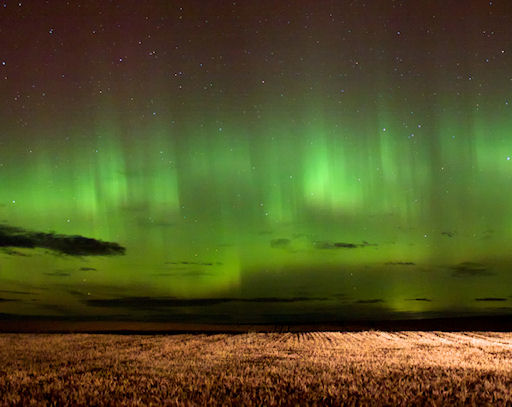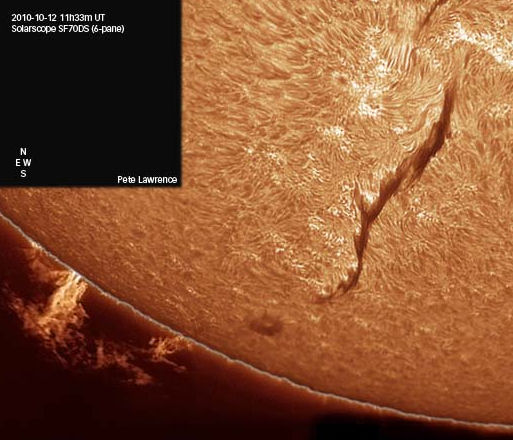iPHONE VS ANDROID! Actually, it doesn't matter which phone you carry. Our cool, new app turns both smartphones into field-tested satellite trackers. Learn more. | | |
SPACE STATION MOVIE: The International Space Station is flying over Europe and North America this week, shining brightly in the pre-dawn sky. On Oct. 11th, German astrophotographer Dirk Ewers trained his 5-inch refractor on the ISS and recorded a must-see movie. "It was nice to see sunlight glinting from the European Columbia module and the autumn-like color of the solar panels," says Ewers. Readers, check the Simple Satellite Tracker (or your cell phone) for a flyby of your own.
MONTANA AURORAS: On Oct. 11th, a bright curtain of Northern Lights unfurled along the US-Canadian border. Watching from Glasgow in northern Montana, Ben Fyngyrz took this picture:

Photo details: Canon EOS 50D, 4 seconds, ISO 1600, f/1.8
"The lights didn't make it all the way down to my latitude," he says , "but the side-view was interesting because it showed the vertical structure of the auroras." More of Ben's photos show dark clouds and a 19th century prairie house backlit by the auroras--very pretty.
The display was triggered by a "south-pointing IMF." In other words, the interplanetary magnetic field near Earth tilted south, opening a crack in Earth's magnetosphere. Solar wind poured in and fueled a G1-class geomagnetic storm. The storm is over now, but the lights are still dancing in the gallery.
UPDATED: October 2010 Aurora Gallery
[previous Octobers: 2009, 2008, 2007, 2006, 2004, 2003, 2002, 2001]
DARK FILAMENT: A dark magnetic filament is stretching around the southeastern limb of the sun. "Seeing was poor today at my observatory in Selsey, UK," reports astrophotographer Pete Lawrence, "but this gorgeous filament made it well worth taking a ride on the atmospheric wobbles."

Magnetic filaments on the sun have a tendency to erupt. This one is attached to sunspot 1112. Does that make it more--or less--stable? No one knows. The magnetohydrodynamics of sunspots is so complex, not even the most powerful supercomputers on Earth can predict when they will explode. Readers with solar telescopes are encouraged to monitor this region for unexpected developments.
more images: from Z. Roy and J. Stetson of South Portland, Maine; from Steve Wainwright of Gower, S.Wales, UK
Potentially Hazardous Asteroids (
PHAs) are space rocks larger than approximately 100m that can come closer to Earth than 0.05 AU. None of the known PHAs is on a collision course with our planet, although astronomers are finding
new ones all the time.
On October 13, 2010 there were 1149 potentially hazardous asteroids.
Notes: LD means "Lunar Distance." 1 LD = 384,401 km, the distance between Earth and the Moon. 1 LD also equals 0.00256 AU. MAG is the visual magnitude of the asteroid on the date of closest approach. | | The official U.S. government space weather bureau |
| | The first place to look for information about sundogs, pillars, rainbows and related phenomena. |
| | Researchers call it a "Hubble for the sun." SDO is the most advanced solar observatory ever. |
| | 3D views of the sun from NASA's Solar and Terrestrial Relations Observatory |
| | Realtime and archival images of the Sun from SOHO. |
| | from the NOAA Space Environment Center |
| | the underlying science of space weather |

